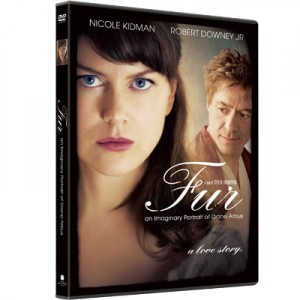Let me state, straight up, that this is not the type of movie that I would normally seek out.
I ran across it the other day while I was helping out the circulation workroom. It caught my eye (Hello, RDJ!) and since working in circ makes me think of college, I decided to check it out.
Back in my undergraduate days, I majored in Women’s Studies. Diane Arbus, the subject of Fur, was a name that often came up in discussions. Arbus was a photographer who is best known for her portraits of “deviant” groups – transvestites, circus performers, nudists. She’s credited for pioneering a new spirit in documentary photography, empathizing with her subjects rather than displaying them.
She’s also an artist I have never really understood. Although people who know a hell of a lot more about art photography than I do have said her photos are astounding, they never really struck me as anything more than voyeuristic .
So – Fur: An Imaginary Portrait of Diane Arbus. I went into it with a little knowledge about the subject and not a whole lot of expectations. I accept that this film is not a “biography” and that plenty of artistic liberty has been taken with Arbus’s life. Since I only have the barest sense of Arbus’s history anyway, I was willing to separate this fantasy from the historical person. Even with that caveat, I don’t think this film works very well.
In the beginning of the film Diane’s a buttoned up homemaker, who acts as her husband’s assistant in their photography business. She’s unhappy, troubled by her “weirdness”, and bullied by her parents and husband. Her life is revolutionized by the appearance of Lionel, a former circus performer who suffers from hypertrichosis. Lionel introduces Diane to his world, populated by transvestites, midgets and circus freaks. Diane’s explorations cause tensions in her marriage, as her newfound freedoms contradict her ordered life.
If I had to pick a word to describe this film, it would be obvious. At the beginning of the film, Diane is buttoned up – literally. When we meet her she’s wearing a heavy grey dress, complete with crinoline, buttoned to her neck. Diane longs to bust out, and again we are treated to the literal interpretation of this, as she unbuttons her dress on the patio during a fur show for her parent’s department store. Diane’s apartment is sterile and neat, all sharp corners and cold neutrals. Lionel’s home is full of found objects, sunken tubs and color washed walls resembling an ancient ruin. This is a neat trick, seeing as they live in the same building. Lionel literally begins spilling over into Diane’s life, which is shown, not at all subtly, by his hair clogging her drains, his objects making their way into her home and finally, a hole in her ceiling which disgorges members of the sub-cultures Lionel inhabits. By the end of the film, Diane’s hair is loose around her shoulders and she wears a bright red, slinky dress. It’s all too on the nose.
I think my biggest problem with the film overall however, is the ending. The final quarter of the film cops out in a big way. Not to get all spoilerific, but why did Lionel have to lose his hair before he and Diane could be intimate? Doesn’t that negate the whole premise of the movie, that Diane loves and celebrates the strange and marginalized? While I enjoy a RDJ nude scene, it would have felt more honest if Lionel had stayed as he was. His stated reason for wanting to lose his hair doesn’t hold up.
I can’t say I enjoyed this movie, however some elements were really well done. Nicole Kidman plays Diane, which works, as she has that whole ice princess/sex kitten dichotomy going on. I don’t like Kidman as an actress, but she was good here. Lionel, who reminded me of the Beast from Cocteau’s film version of Beauty and the Beast, is played by Robert Downey, Jr. Using only his eyes and voice, Downey manages to make the hair-afflicted Lionel tremendously appealing – it’s to his credit that we don’t doubt the attraction between Lionel and Diane. Also, this is a pretty movie to watch. Rich and expressive colors and textures fill the screen. Lionel’s hair, Diane’s skin – both seem to glow and beg to be touched.
While I’m glad I watched the movie, I wouldn't recommend it to anyone else. Ultimately, I’m not sure what it was trying to accomplish. I don’t feel like I learned anything about the actual Diane Arbus from this film, as the filmmaker states at the beginning that it’s entirely fantasy. I don’t feel like it made any statement about finding beauty in unusual places. Beautiful images aside,I can’t figure out why this movie exists. However, it did inspire a 800+ essay from me, so maybe it was more successful than I thought.


No comments:
Post a Comment